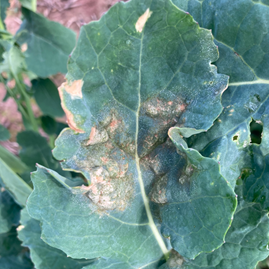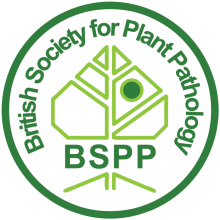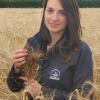Damage and Economic Importance
The disease typically reduces yield by a third of the incidence (90% plants affected at early stem extension causes 30% yield loss) and on average, UK yield losses equate to £110-160M per year. The disease has increased in southern Britain (AHDB east and west regions) in recent years due to favourable weather, changes in fungicide use and cultivars grown. For disease-prone regions it is recommended to use relatively resistant varieties (and see fungicide information below).
Appearance and Lifecycle
Typical symptoms:
Visible symptoms appear after a long period of symptomless growth, as speckles of white spore pustules on leaves, stems and pods. The spores are only visible after a period of dry weather. As infections mature, the fungus can also cause bleaching and stunting of leaves in affected positions causing leaf distortion and by spreading to the growing point, can cause stunting of the whole plant.
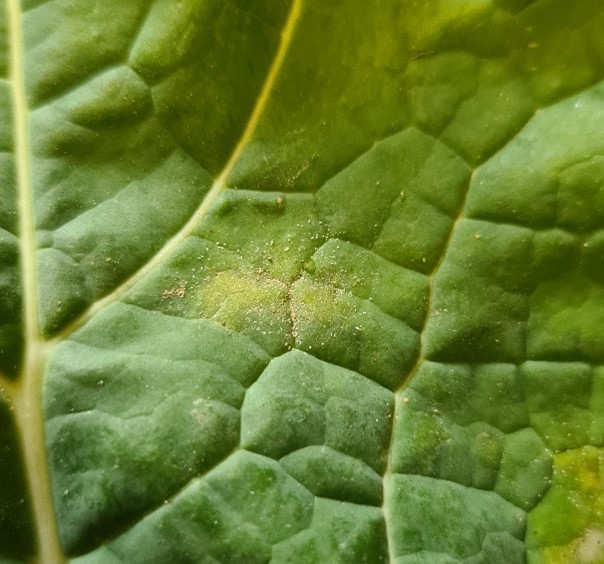
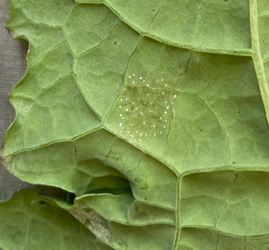
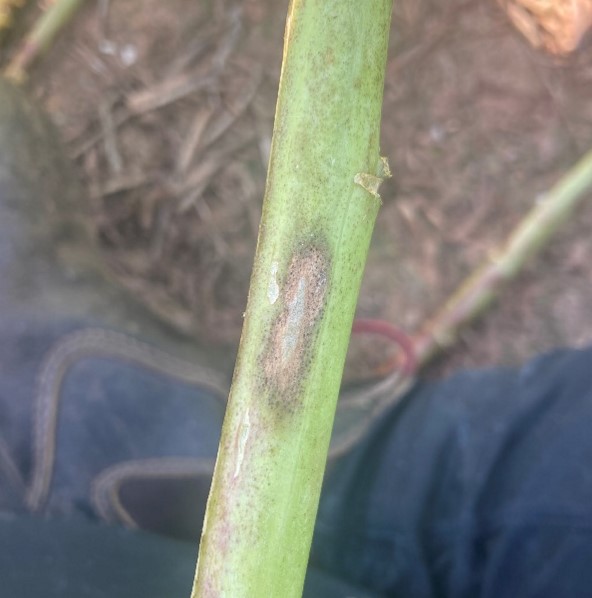
Lifecycle:
- The fungus survives over summer on crop debris, volunteers and some weeds, from which it can spread short distances (less than a few metres) by rain-splashed spores called conidia. It can also develop structures called apothecia, which release wind-dispersed sexual spores (ascospores) that can blow long distances but mostly affect crops within 300m of the debris.
- After initial infections during the autumn, rain-splashed spores from infected plants cause disease intensification. Because of this dispersal method, new infections develop around initial primary infection "foci" and the disease appears to be patchy within the field.
- A second phase of wind-dispersed ascospores often occurs in the spring to spread the disease again to new crops and higher positions in the pod canopy, which can lead to early pod senescence and pod-shatter.
The amount of stem and pod infection determines the amount of inoculum for winter oilseed rape crops in the next season and along with weather records, is the basis for a forecast of LLS severity the following season – see Light leaf spot forecast | AHDB. This forecast indicates the predicted disease severity in different parts of the country and a crop specific interactive forecast allows growers to input various options to assess the effect of cultivar choice, sowing date and fungicide regime.
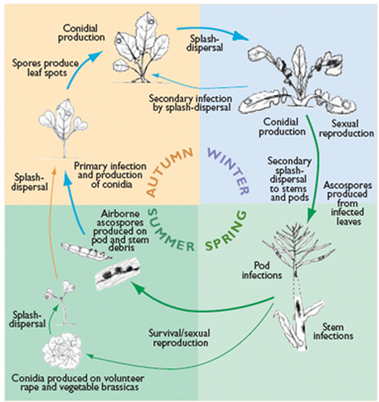
Management Recommendations:
Key drivers of risk:
- High levels of infection in the previous summer
- Presence of infected residues
- Close proximity to oilseed rape fields
- Early sowing date
- Low resistance varieties
- Using home saved seed from heavily infected crops
Fungicide Choice
Information on fungicide efficacy is available from the AHDB. It is important to apply fungicides before the disease becomes severe. Due to a long symptomless phase of infection, it is a good idea to check reports of disease monitoring and disease forecasts (above). For fungicide efficacy against LLS – see Fungicide performance update and FRAG UK Fungicide resistance management in OSR.
Most currently recommended products contain azoles, mixed or alternated with other modes of action such as SDHIs or strobilurins. These are best applied ahead of significant disease development. A mid-autumn application is suggested in regions prone to high levels of disease and this is often before visible symptoms occur, although backward crops may suffer a yield reduction if autumn-applied fungicides have a growth regulatory affect. Fungicides give little control on crops that are already severely infected. In addition, a spray at the start of stem extension is recommended if the disease incidence is over 15%.
The disease is hard to see following wet weather, except for symptoms of leaf bleaching and distortion. Disease assessment can be improved by taking about 20 low-mid-canopy leaves, shake most water off and incubate them in a closed plastic bag in a cool room (ideally 5-10°C) for 3-4 days before looking at them. Any sporulation should be clear on the leaves if the disease is present.
Varietal Resistance
Having a variety with a higher LLS rating can help reduce levels of infection within the crop. For 2022-23, the current resistance scores vary from 5 - 8 in the east-west region or 6 - 8 in the north region, so none are completely resistant. For information on current cultivar resistance, please see the AHDB Recommended List, scroll past the wheat, barley and oats section to the winter oilseed rape section.
Cultural Control
As OSR volunteers from the previous season’s crop debris, or brassica cover crops can act as a reservoir of the disease, having a good crop rotation that maximises the separation of new OSR fields from old (at least 300 metres) can help to reduce epidemics. OSR stubbles on farm should be cultivated/ploughed to bury any infected crop debris.
Drill later if possible, particularly in higher-risk situations as this reduces the chance of crop emergence coinciding with the first release of spores from infected crop debris.
Monitoring
A major challenge with LLS is that it is notoriously difficult to identify, particularly in the early stages of infection when symptoms are minimal or not visible at (see photo examples below). Regular monitoring and crop walking is key to knowing when and in what capacity to respond to infection. There are several tools that can now be used to aid identification:
Bayer SpotCheck is a fantastic service in collaboration with ADAS, providing growers and agronomists with free conclusive diagnosis of disease in oilseed rape crops, with particular focus on light leaf spot. A sample of 30-35 leaves is incubated for 48 hours and results returned within 7 working days. More information can be found on their website here.
SwiftDetect is a rapid testing service that can determine LLS presence before symptoms are visible, claiming a turnaround time of 1 business day. They also test for other diseases in wheat and barley. Visit the SwiftDetect page on FarmPEP for further information (see related organisations below).
Multispectral imaging is another precision technology that is being developed that uses image analysis of leaves to detect the disease in early stages. This could allow photos to be taken of a crop canopy
Using these services and development of precision technologies to aid crop monitoring can help the farmer/grower to effectively plan targeted sprays. This will not only reduce overall costs but increase the efficacy of chemical applications and reduce crop protection use, helping to safeguard against fungicide resistance. In a future where integrated pest management (IPM) is essential, this technology will help farmers to justify fungicide applications. The technology can also benefit plant breeders seeking to develop new resistant varieties.
Related Links:

